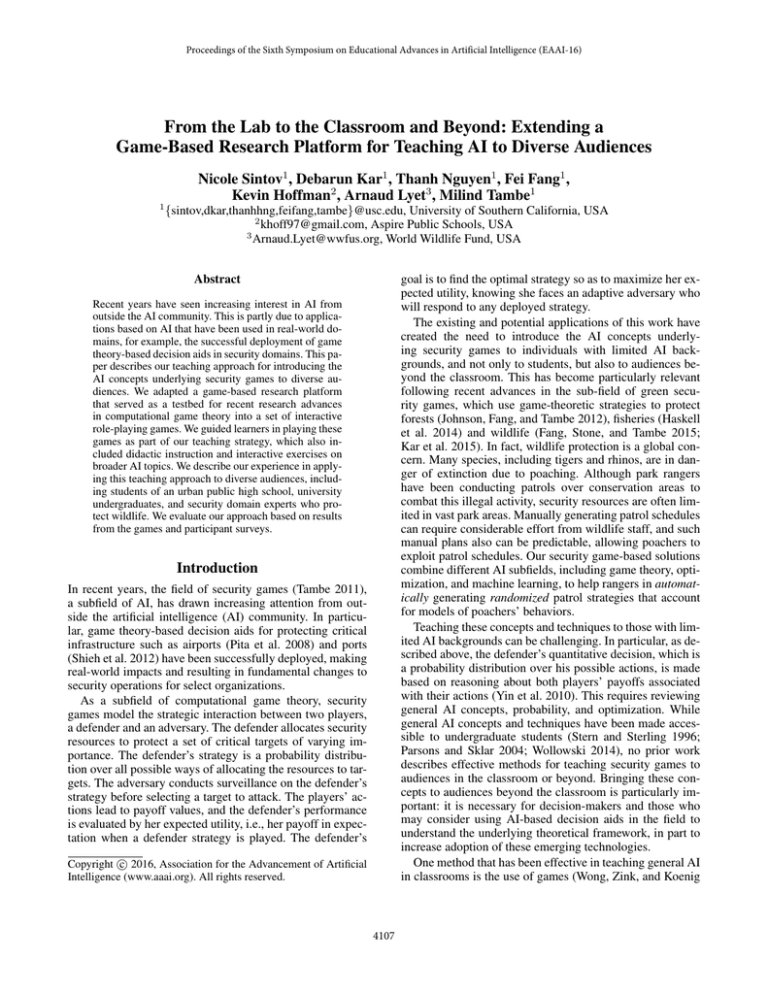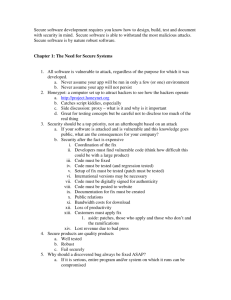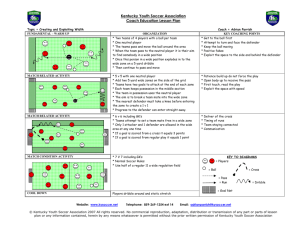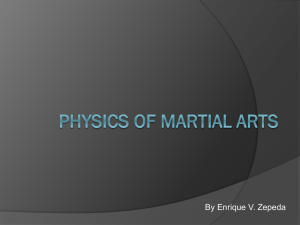
Proceedings of the Sixth Symposium on Educational Advances in Artificial Intelligence (EAAI-16)
From the Lab to the Classroom and Beyond: Extending a
Game-Based Research Platform for Teaching AI to Diverse Audiences
1
Nicole Sintov1 , Debarun Kar1 , Thanh Nguyen1 , Fei Fang1 ,
Kevin Hoffman2 , Arnaud Lyet3 , Milind Tambe1
{sintov,dkar,thanhhng,feifang,tambe}@usc.edu, University of Southern California, USA
2
khoff97@gmail.com, Aspire Public Schools, USA
3
Arnaud.Lyet@wwfus.org, World Wildlife Fund, USA
goal is to find the optimal strategy so as to maximize her expected utility, knowing she faces an adaptive adversary who
will respond to any deployed strategy.
The existing and potential applications of this work have
created the need to introduce the AI concepts underlying security games to individuals with limited AI backgrounds, and not only to students, but also to audiences beyond the classroom. This has become particularly relevant
following recent advances in the sub-field of green security games, which use game-theoretic strategies to protect
forests (Johnson, Fang, and Tambe 2012), fisheries (Haskell
et al. 2014) and wildlife (Fang, Stone, and Tambe 2015;
Kar et al. 2015). In fact, wildlife protection is a global concern. Many species, including tigers and rhinos, are in danger of extinction due to poaching. Although park rangers
have been conducting patrols over conservation areas to
combat this illegal activity, security resources are often limited in vast park areas. Manually generating patrol schedules
can require considerable effort from wildlife staff, and such
manual plans also can be predictable, allowing poachers to
exploit patrol schedules. Our security game-based solutions
combine different AI subfields, including game theory, optimization, and machine learning, to help rangers in automatically generating randomized patrol strategies that account
for models of poachers’ behaviors.
Teaching these concepts and techniques to those with limited AI backgrounds can be challenging. In particular, as described above, the defender’s quantitative decision, which is
a probability distribution over his possible actions, is made
based on reasoning about both players’ payoffs associated
with their actions (Yin et al. 2010). This requires reviewing
general AI concepts, probability, and optimization. While
general AI concepts and techniques have been made accessible to undergraduate students (Stern and Sterling 1996;
Parsons and Sklar 2004; Wollowski 2014), no prior work
describes effective methods for teaching security games to
audiences in the classroom or beyond. Bringing these concepts to audiences beyond the classroom is particularly important: it is necessary for decision-makers and those who
may consider using AI-based decision aids in the field to
understand the underlying theoretical framework, in part to
increase adoption of these emerging technologies.
One method that has been effective in teaching general AI
in classrooms is the use of games (Wong, Zink, and Koenig
Abstract
Recent years have seen increasing interest in AI from
outside the AI community. This is partly due to applications based on AI that have been used in real-world domains, for example, the successful deployment of game
theory-based decision aids in security domains. This paper describes our teaching approach for introducing the
AI concepts underlying security games to diverse audiences. We adapted a game-based research platform
that served as a testbed for recent research advances
in computational game theory into a set of interactive
role-playing games. We guided learners in playing these
games as part of our teaching strategy, which also included didactic instruction and interactive exercises on
broader AI topics. We describe our experience in applying this teaching approach to diverse audiences, including students of an urban public high school, university
undergraduates, and security domain experts who protect wildlife. We evaluate our approach based on results
from the games and participant surveys.
Introduction
In recent years, the field of security games (Tambe 2011),
a subfield of AI, has drawn increasing attention from outside the artificial intelligence (AI) community. In particular, game theory-based decision aids for protecting critical
infrastructure such as airports (Pita et al. 2008) and ports
(Shieh et al. 2012) have been successfully deployed, making
real-world impacts and resulting in fundamental changes to
security operations for select organizations.
As a subfield of computational game theory, security
games model the strategic interaction between two players,
a defender and an adversary. The defender allocates security
resources to protect a set of critical targets of varying importance. The defender’s strategy is a probability distribution over all possible ways of allocating the resources to targets. The adversary conducts surveillance on the defender’s
strategy before selecting a target to attack. The players’ actions lead to payoff values, and the defender’s performance
is evaluated by her expected utility, i.e., her payoff in expectation when a defender strategy is played. The defender’s
c 2016, Association for the Advancement of Artificial
Copyright Intelligence (www.aaai.org). All rights reserved.
4107
2010; DeNero and Klein 2010). However, little evidence
speaks to the efficacy of using security games to pique interest in or teach about AI in general. Further, no data exists
on teaching these concepts beyond the classroom.
This paper describes our novel teaching approach that
leveraged a game-based research platform, and moved it to
the classroom and beyond. Our computer-based game was
initially developed and used to gather data via human subjects experiments in a study of green security games (Kar
et al. 2015). We modified the game to increase suitability
as a hands-on learning tool. We describe this approach and
our experiences introducing general AI and security game
concepts to several audiences, including: (1) students of an
urban public high school; (2) undergraduate students at a
large private university; and (3) law enforcement officers
and rangers who work in wildlife protection in Indonesia. In
teaching each of these audiences, we delivered didactic instruction on AI and game theory, followed by guiding learners in playing the role-playing games.
We evaluate our teaching approach in two ways. First,
we show how participants played the games and the effectiveness of their defender strategies, represented as defender utility, i.e., the defender’s overall payoff obtained
when peers play as poachers. Second, we assess participants’ perceived value of our approach using surveys. We
make recommendations for teaching similar topics to audiences with limited AI backgrounds.
Figure 1: Online computer game interface (Kar et al. 2015).
generates the defender strategy according to a game-theory
based algorithm and the participants play as poachers. In the
original study, the game was played over multiple rounds.
After each round, data from participants’ actions were collected, based on which a new defender strategy was generated for use in the next round.
Players in the original game experiment always played
as poachers. They were first primed with a background
story about the hardships of a poacher’s life, then instructed to look throughout the park to place a snare to
catch a hippopotamus. We adapted this for our teaching approach by creating a set of paired role-playing games and
the opportunity for learners to play as both poachers and
rangers. Specifically, we created board games mimicking the
computer-based game. Board games used the same background story and 5 by 5 grid as the online game. However,
instead of using the QENP map and images of hippos to
show the relative value of different areas, the board games
used movable figures to represent animal distributions. This
did not require any facilities such as computers, making it
easily scalable to other educational settings. Also, in board
games, learners took turns playing the roles of ranger and
poacher, moving figures of rangers across the board to generate the defender strategies, and moving poacher figures to
represent poacher decision-making. A subset of our audiences also played an adapted version of the computer-based
game as poachers.
Background and Role-Playing Games
As described above, green security games involve the development and application of game-theoretic strategies to
protect forests (Johnson, Fang, and Tambe 2012), fisheries
(Haskell et al. 2014) and wildlife (Fang, Stone, and Tambe
2015; Kar et al. 2015). A game-theory based decision-aid
called PAWS (Yang et al. 2014) (Protection Assistant for
Wildlife Security) was developed in part based on a study of
green security games for the purpose of protecting wildlife
from poaching. The study used an online computer game
(Figure 1) to understand human decision making through a
set of human subjects experiments (Kar et al. 2015). Our
role-playing games were developed based on this game.
The game begins with a background story in the domain
of wildlife protection. More specifically, the game simulates
a real-world poaching scenario in Queen Elizabeth National
Park (QENP) in Uganda. An image of the park is depicted
and is discretized into a 5 by 5 grid. Animals (hippos) are
shown in varying densities across the grid. There are two
players: (1) the law enforcement officer (hereafter referred
to as defender or ranger) and (2) the poacher. The defender
moves first, deciding a patrol strategy, which is a randomized patrol schedule for park rangers. This is represented as
the probability a ranger will be in each grid cell. Then the
poacher can walk through the park to see the relative odds
of being successful in a poaching expedition, and decide
to poach / place a snare in a given area (grid cell). Then a
sample of the rangers’ actual location is randomly generated
from the patrol strategy. If a ranger is in the same grid cell
as the poacher, the poacher will get caught and lose money,
otherwise the poacher wins and gains money. The computer
High School Students
Background An AI unit was delivered to a group of
high school students as the last unit of study in a yearlong engineering elective course. The structure of the unit
was designed based on Dr. Milind Tambe’s undergraduatelevel course at the University of Southern California entitled
CS499: Artificial Intelligence and Science Fiction (Tambe,
Balsamo, and Bowring 2008). The high school unit was developed during summer 2014 in Dr. Tambe’s Teamcore research group, funded by the National Science Foundation’s
Research Experience for Teachers (RET) program called
ACCESS 4Teachers. The primary objective of this unit was
to introduce state-of-the-art concepts in AI to high school
students. In addition, basic concepts in game theory were
introduced. Students also participated in the interactive roleplaying games including: (i) playing the board games as
4108
rangers, designing defender strategies; and (ii) playing the
board game and computer game as poachers against the defender strategies developed by other students in the class and
also the AI-generated algorithms.
Participants The 30 students who participated in the elective course were juniors and seniors at an urban public high
school located in Los Angeles. All students were of Hispanic
or African-American origin, resided in South Los Angeles,
and the majority qualified for free or reduced price lunch.
Figure 2: Defender utilities for each high school student
group.
Overall Course Content A key tenet of this unit was that
AI concepts can be made accessible to anyone in the right
context. We also placed an emphasis thinking about problems from a quantitative perspective, and considering how
human-like qualities (emotions, risk-aversion, etc.) could be
quantified to enable computers to act in an intelligent fashion. Students read Asimov and watched Stark Trek, and
debated the meaning of intelligence based on these stories. They were then taught about how quantitative decisions could be made. The teacher delivered lectures on unit
content, and skills were reinforced by students completing
worksheets and applied problems. More pop-culture examples were given, ranging from an exploration of the California Lottery to the popular game show Deal or No Deal?.
For many students, a full grasp of the material required a
review of fraction operations and probability, as well as an
introduction to the concept of expected value.
ignoring important factors like animal distribution and distance.
Feedback A total of 13 (7 males, 5 females, 1 declining to
state) out of 30 students responded to a survey that assessed
their experiences in the unit. Questions assessed perceived
educational value of the unit, likelihood of recommending
the unit to others, and the unit’s impact on their overall
interest in AI. Responses were provided on likert scales
(e.g., ranging from 1=strongly disagree to 7=strongly agree).
Open-ended questions assessed general likes and dislikes.
The mean age of respondents was 18.1 years (SD=0.8).
More than 90% responded that they would recommend the
activity to other high school students. Additionally, more
than 70% agreed (somewhat or more) that the activity increased their interest in AI, and 93% agreed (somewhat or
more) that the activity was a valuable learning experience.
Open-ended responses indicated that respondents particularly enjoyed the interactive game aspect of the course. The
least enjoyable aspects of the course were those that students
felt were tedious or repetitive, such as calculating probabilities.
Final Project The final project for the unit used the roleplaying board game. To reinforce the idea of quantitative
decision-making, students were tasked with designing their
own defender strategies using short formulas to allocate
a limited number of ranger-hours to the 25 grid cells in
the game. Students worked independently or in groups to
complete the strategies (in this case, using Google spreadsheets). These spreadsheets were then used to generate
twelve distinct games based on the student-designed defense
strategies. Taking on the role of poacher, students played
the games against defender strategies generated by other
groups. Finally, students reviewed the results of their strategies, made adjustments, and presented their work to explain
where initial strategies were particularly successful or unsuccessful.
University Students
Background AI and Security Games were introduced to a
class of University of Southern California (USC) Freshmen
as a 2-week unit in their Freshman Academy course in fall
2015, which is an introductory engineering course. Similar
to the high school course described in the previous section,
the 2-week AI unit portion of the course was also designed
based on Dr. Tambe’s seminar at USC entitled CS499: Artificial Intelligence and Science Fiction. In addition to the
introduction of basic concepts in AI, as part of the AI unit,
the students also participated in interactive activities including: (i) playing board games as rangers to design strategies
to improve patrolling effectiveness; (ii) playing board games
as poachers to measure the effectiveness of strategies developed by peers and also the AI algorithms.
Results of Role-Playing Game Different groups employed different methods in designing defender strategies.
While some chose to concentrate ranger patrols in areas
dense with animals, often associated with a high probability
of failure, others developed strategies in which the expected
value for poachers was nearly zero. Fig. 2 shows the expected defender utilities obtained by each of the 12 student
groups based on the attacks conducted on the other teams’
defender strategies. The team with the highest expected utility generated a strategy that not only considered the animal
densities, but also the distance from the poacher’s starting
location, placing lower coverage in cells farther away from
the poacher’s starting location. The team with the lowest
expected utility placed maximum coverage (100%) on the
highest animal density cell and divided remaining resources
(ranger-hours) uniformly across all remaining targets, thus
Participants The 30 students who took part in the AI unit
were all USC freshmen majoring in engineering. As mentioned, the unit was part of a 2-unit course aimed at introducing students to ongoing research at USC across various
engineering disciplines.
Overall Course Content The unit consisted of didactic
instruction and discussion of basic concepts in AI and game
theory, including applications to solving real-world problems. University professors and CEOs of technical startups
4109
Figure 3: Defender utilities obtained by each group
(a) Computer games
facilitated discussion around the use of AI in security applications, painting a comprehensive picture of the various
ways in which AI can influence day-to-day life. To understand different concepts such as the notion of payoffs
in a game context, the classic Prisoner’s dilemma problem
in game theory was discussed. This provided foundational
knowledge to facilitate learning about the payoffs in the roleplaying games (i.e., the animal densities and penalties).
Similar to the final project for high school students in
the previous section, following the didactic and discussionbased elements of the unit, students played the role-playing
board game that mimicked the computer-based game. Here,
students first played as rangers. The class was divided into
seven groups, each of which designed its own defender strategy on a game board. Some groups chose to allocate ranger
coverage in proportion to the number of animals, while others placed highest probability of capture at the highest animal density region and uniform everywhere else; some others developed strategies in which the expected value for
poachers was nearly zero across all of the regions of the
park. Each group’s strategy was then shown to the other
groups, who played the game in the poacher role against
their peers’ defender strategies.
The following week, the results of the board games were
presented. Basic game-theoretic concepts such as Maximin
were then explained. This led students to focus on subsets
of information in decision-making: for instance, in the case
of Maximin, when only information about the payoffs in the
game is available, how can the most conservative strategy
be developed? This was an important concept to help teams
learn how to improve their strategies.
(b) Board games
Figure 4: Participants played Role Playing Games
Additionally, more than 69% of students noted that the activity increased their interest in AI at least somewhat, and
more than 80% agreed (somewhat or more) that the activity was a valuable learning experience. Qualitative data indicated that respondents particularly enjoyed the interactive
aspect of the unit. The least enjoyable aspects of the unit
were cases where students in a team couldn’t agree on a particular strategy.
Workshop on Wildlife Protection in Indonesia
Overall Course Content A 3-day workshop was developed in collaboration with the World Wildlife Fund (WWF)
to demonstrate the value of AI-based solutions for security (i.e., PAWS software), to security experts who protect wildlife. The workshop was held in Bandar Lampung,
Sumatra, Indonesia in May 2015. We sought to teach how
AI algorithms fed with partial information can generate patrol strategies that can outperform those generated by field
experts with extensive knowledge of the system. We used
the paired role-playing games to teach about these concepts
and real-world applications that leverage them. In addition,
we delivered didactic tutorials on theory and applications
of agent-based modeling, game theoretic concepts, and security games. Learners also played the paired role-playing
games, playing the computer-based games and board games
as poachers and rangers. They also discussed in groups various challenges faced in wildlife protection and solutions for
those challenges. Finally, they generated and shared ideas
for improving patrolling effectiveness. These interactive exercises provided learners with a new lens for understanding
poachers’ behaviors and weaknesses of manual patrolling
strategies, as well as introducing the methodology and advantages of PAWS game-theoretic solutions.
Results of Role-Playing Game Complementing the high
school students’ results (Fig. 2), the resulting defender utilities for each university student group playing the board
games is shown in Fig. 3. The team with the lowest defender
utility (G3) placed very low coverage (< 0.40) in the highest
animal density cell and as expected, all the other teams attacked that cell. Similar results were obtained for group G7
which placed a coverage of 0.50 on the highest animal density target. Other teams performed reasonably well but none
performed better than Maximin, which would have resulted
in a defender expected utility of -2.17.
Participants A total of 28 participants (26 males and
2 females) attended the PAWS workshop representing the
five primary groups (either Government or NGOs) involved
in protecting wildlife in Bukit Barisan Selatan (BBS) and
Tesso Nilo (TN) national parks in Indonesia: Indonesian National Park Service, WWF, Wildlife Conservation Society
(WCS), Indonesian Rhino Foundation (YABI), and Prosecution Officers from the Court. These individuals were
park rangers and law enforcement officers with a great deal
of experience in wildlife protection and domain expertise
in wildlife crime and protection. The mean age was 35.0
years (SD = 7.5), and mean years of formal schooling
Feedback A total of 24 (7 males and 17 females) out of
30 students responded to a survey that assessed their experiences in the unit. Questions mirrored those administered to
the high school students. The mean age of the sample was
18.22 years. More than 65% of students responded that they
would recommend the activity to other university students.
4110
was 14.0 (SD = 3.1). Approximately 60% of the respondents identified their job sector as wildlife/national park
protection, 20% as nonprofit/NGO, and 20% as law enforcement, and overall they had an average of 9.6 years
of experience working in wildlife protection (SD = 6.1).
Rangers
from
National
Park,
WWF, WCS, and
YABI
directly
conduct
field
patrols over conservation areas,
whereas the prosecutors
report
Figure 5: Workshop participants
cases to lawyers
and judges who
can open official investigations. Participants were native
speakers of Bahasa Indonesia. The instructors delivered
the workshop in English and interpreters translated all the
material throughout the 3-day course. All written materials
were made available in both English and Bahasa Indonesia.
including different groups of rangers/poachers and different
types of animals, the role of local communities, and interactions between these components.
Role-Playing Games In addition to the tutorials and discussions, participants played the paired role-playing games
as poachers and rangers (on computer and board games).
Every participant played five rounds of the computer-based
games as poachers. After each round, the poacher behavior
models were updated based on participants’ responses, and
each subsequent game used a defender strategy created using
these updated models. By playing these poaching games in a
repeated fashion, the participants developed a better understanding of how poachers may react to rangers’ strategies.
They also learned about weaknesses of defender strategies,
aiding them in better designing and testing patrol strategies
in the future. Finally, participants learned how patrolling
strategies generated by PAWS adapt and improve over time
as more data are collected.
Additionally, we created physical board games which
mimicked the computer-based game, replicating exactly
the animal densities, rewards and penalties. In these board
games, the participants were divided into two groups, each
which in turn played as rangers (who created patrol strategies) and poachers (who decided where to poach in games
generated by the other team). By playing these board games
in both roles, participants learned how security games are
created, how poachers might react to different defender
strategies, and how AI software such as PAWS makes decisions based on models of players’ behaviors.
On the final day, we presented the game results, i.e., the
defender utilities based on poachers’ decisions in the online
games. The PAWS strategy improved over time, as indicated
by increasing rangers’ utility.
Security Game Tutorials On the first day of the workshop, we introduced security game examples, beginning
with a basic security game. We explained how the defender
could optimally conduct patrols over targets and how attackers may respond against that strategy. We next covered
(1) real-world security problems and applications of security games for protecting critical infrastructure and (2) challenges in wildlife protection and the application of security games to this domain, reviewing how adversaries’ behaviors are modeled and how to optimize patrolling strategies through allocating limited security resources. Finally,
we presented our PAWS software — which was built based
on security game models for addressing wildlife protection
problems — describing data inputs (e.g., animal density,
poaching data) and what outputs are generated (e.g., models of poachers’ behaviors and suggested patrolling routes
for rangers). We described how similar approaches had been
previously successfully used in the wildlife domain, and
how they could be used on Sumatra via PAWS. This was
our first introduction of PAWS to rangers in Indonesia, with
the goal of obtaining feedback to improve PAWS and using
it to generate patrols there in the future.
ĞĨĞŶĚĞƌhƚŝůŝƚLJ
Results of Role Playing Games Fig. 6 shows the defender utilities obtained by deploying PAWS strategies
over several rounds
WĞƌĨŽƌŵĂŶĐĞŽĨWt^
against workshop
ϭ͘ϯ
Wt^
participants.
In
DĂdžŝŵŝŶ
the figure, higher
Ϭ͘ϴ
positive
values
Ϭ͘ϯ
along the y-axis
ͲϬ͘Ϯ
indicate
better
ZŽƵŶĚϭ ZŽƵŶĚϮ ZŽƵŶĚϯ ZŽƵŶĚϰ
defender results.
We observe that
Figure 6: Defender utilities.
PAWS performs
significantly better than a conservative game-theoretic
strategy like Maximin, and completely outperforms the
workshop participants.
Discussion Sessions Participants engaged in several discussion sessions on topics including Resources (i.e., factors
that motivate people to enter protected areas), Illegal Activities (i.e., types of illegal activities in conservation areas), and Wildlife Protection (i.e., improving security approaches). They exchanged knowledge about challenges in
wildlife protection and generated potential solutions. For example, participants identified as a key challenge the existence of well-organized poacher groups who leverage information flows via local communities, obtaining information on ranger locations. We encouraged participants to develop solutions and provide feedback that could be quantified in game-theoretic models and incorporated into PAWS
software. The ideas generated were valuable for specifying
additional modeling components to incorporate in PAWS,
Feedback All respondents rated the usefulness of the
workshop as neutral or better, with 86% rating it as at least
somewhat useful (mean = 5.7 on a scale of 1 [completely
useless] – 7 [extremely useful], SD = 0.8). More than 96%
of respondents reported that the workshop was at least somewhat important (mean = 6.0 on a scale of 1 [extremely
unimportant] – 7 [extremely important], SD = 1.0). Additionally, more than 86% of respondents reported that they
were at least somewhat likely to recommend the workshop
4111
to others in relevant fields (mean = 6.04 on a scale of 1
[strongly disagree] – 7 [strongly agree], SD = 1.04).
Based on open-ended responses, respondents largely supported the purpose of the PAWS software. Roughly half
(n = 15) commented that it served to optimize patrols and
would make the job of patrolling easier. When asked about
PAWS software limitations, respondents recommended increasing complexity of models, including approximately
one-third (n = 10) of respondents suggesting that dynamic
animal distribution models be added. Respondents also suggested improving poaching predictions and that further research and testing be conducted prior to deployment.
ing of the theory on which these applications are based could
improve adoption rates of emerging AI-based decision aids.
Acknowledgements
This work was supported by MURI Grant W911NF-11-1-03
and World Wildlife Fund PAWS Anti-Poaching Grant.
References
DeNero, J., and Klein, D. 2010. Teaching introductory artificial intelligence with pac-man. In EAAI.
Fang, F.; Stone, P.; and Tambe, M. 2015. When security
games go green: Designing defender strategies to prevent
poaching and illegal fishing. In IJCAI.
Haskell, W. B.; Kar, D.; Fang, F.; Tambe, M.; Cheung, S.;
and Denicola, L. E. 2014. Robust protection of fsheries
with COmPASS. In IAAI.
Johnson, M. P.; Fang, F.; and Tambe, M. 2012. Patrol strategies to maximize pristine forest area. In AAAI.
Kar, D.; Fang, F.; Fave, F. D.; Sintov, N.; and Tambe, M.
2015. a game of thrones: When human behavior models
compete in repeated stackelberg security games. In AAMAS.
Parsons, S., and Sklar, E. 2004. Teaching AI using LEGO
mindstorms. In AAAI Spring Symposium.
Pita, J.; Jain, M.; Western, C.; Portway, C.; Tambe, M.; Ordonez, F.; Kraus, S.; and Paruchuri, P. 2008. Deployed ARMOR protection: The application of a game theroetic model
for security at the Los Angeles International Airport. In AAMAS.
Shieh, E.; An, B.; Yang, R.; Tambe, M.; Baldwin, C.; DiRenzo, J.; Maule, B.; and Meyer, G. 2012. PROTECT: A
deployed game theoretic system to protect the ports of the
United States. In AAMAS.
Stern, L., and Sterling, L. 1996. Teaching ai algorithms using animations reinforced by interactive exercises. In Proceedings of the 2Nd Australasian Conference on Computer
Science Education, ACSE ’97, 78–83. New York, NY, USA:
ACM.
Tambe, M.; Balsamo, A.; and Bowring, E. 2008. Using
science fiction in teaching artificial intelligence. In AAAI
Spring Symposium, 86–91.
Tambe, M. 2011. Security and Game Theory: Algorithms,
Deployed Systems, Lessons Learned. Cambridge University
Press.
Wollowski, M. 2014. Teaching with watson. In EAAI, 3044–
3049.
Wong, D.; Zink, R.; and Koenig, S. 2010. Teaching artificial
intelligence and robotics via games. In EAAI.
Yang, R.; Ford, B.; Tambe, M.; and Lemieux, A. 2014.
Adaptive resource allocation for wildlife protection against
illegal poachers. In AAMAS.
Yin, Z.; Korzhyk, D.; Kiekintveld, C.; Conitzer, V.; ; and
Tambe, M. 2010. Stackelberg vs. nash in security games:
Interchangeability, equivalence, and uniqueness. In AAMAS.
Conclusion
This paper describes a novel approach that leveraged a
game-based research platform to teach general AI and gametheoretic concepts to several audiences. These included students at an urban public high school, university undergraduate students, and law enforcement officers and park rangers
who protect wildlife in Indonesia. The findings highlight the
value of our game platform for teaching concepts in AI to
learners representing a broad swath of age, gender, and cultural backgrounds.
Across these diverse audiences, a teaching method that
proved to be effective was engaging learners in role-playing
games. Members of all three audiences played the role of
two different actors as part of our paired role-playing games,
which included both computer and board games: (1) playing as rangers, they generated defender strategies to protect
against poachers’ attacks; (2) as poachers, they attempted
to outsmart the defender strategies generated by their peers
to earn the highest possible rewards. This methodology not
only gave learners valuable hands-on experience in complex
AI and game-theoretic concepts, but also in the development
of real-world software applications for security. One limitation of our game is it is unclear how it would generalize to
teaching AI topics beyond game theory and security games.
In the future, we plan to develop activities focusing on other
AI topics that can be integrated into our overall teaching approach. For instance, we will create an activity for learners
to analyze defender strategies in depth, bringing to light subtle human biases that may impact initial strategies, thereby
highlighting benefits of AI agents (compared to humans) in
decision-making.
Participant feedback was consistently positive, with the
majority of participants from all three audiences rating the
learning experiences as useful, and in the case of the university and high school students, increasing their interest in AI.
As well, most participants indicated they would recommend
the learning activity to others. These results are particularly
notable given the wide age range and cultural backgrounds
of participants, and suggests that our approach was broadly
accessible and engaging.
These findings also suggest that our approach could be applied successfully to additional audiences. A possible additional target group is security organizations who could benefit from security applications based on AI and game theory.
Enhancing decision-makers’ and field officers’ understand-
4112





